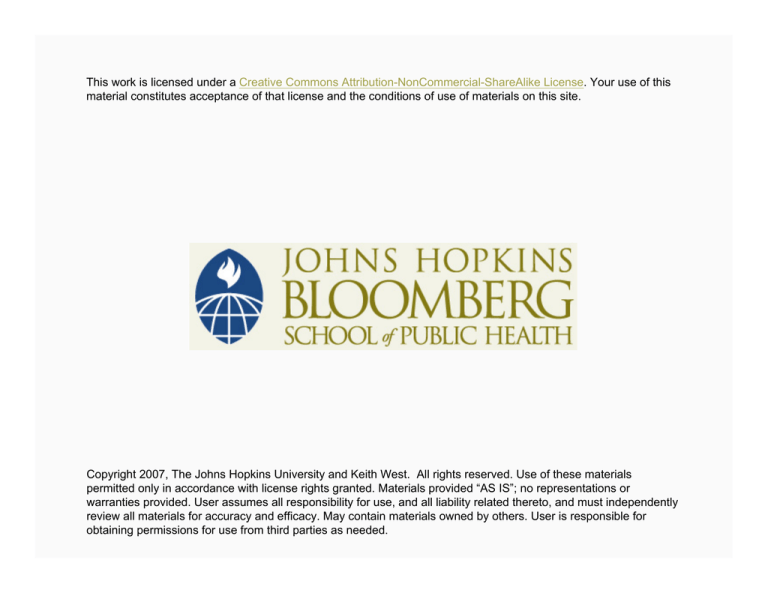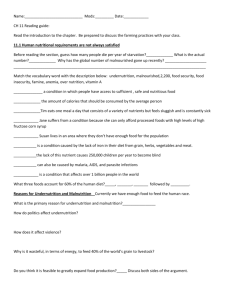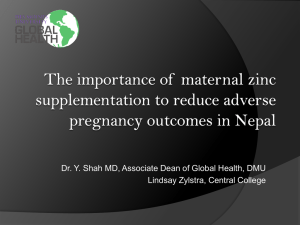
This work is licensed under a Creative Commons Attribution-NonCommercial-ShareAlike License. Your use of this
material constitutes acceptance of that license and the conditions of use of materials on this site.
Copyright 2007, The Johns Hopkins University and Keith West. All rights reserved. Use of these materials
permitted only in accordance with license rights granted. Materials provided “AS IS”; no representations or
warranties provided. User assumes all responsibility for use, and all liability related thereto, and must independently
review all materials for accuracy and efficacy. May contain materials owned by others. User is responsible for
obtaining permissions for use from third parties as needed.
Interactions between Nutrition and
Infection in the Developing World
Keith P. West, Jr., DrPH, MPH
Johns Hopkins University
Keith P. West, Jr., DrPH, MPH
George G. Graham Professor of Infant
and Child Nutrition in the Department of
International Health at the Johns Hopkins
Bloomberg School of Public Health
Has worked in international health for
three decades, concentrating on the epidemiology and
prevention of malnutrition in the developing world
Presently directing a large research project on maternal
and child micronutrient deficiency prevention in northern
Bangladesh
3
Overview
Section A
− Defining and Quantifying Undernutrition
Section B
− The Effects of Undernutrition on Infection
Section C
− Micronutrient Deficiencies
4
Section A
Defining and Quantifying Undernutrition
Definitions Related to Undernutrition
Undernutrition
− Result of undernourishment, poor absorption and/or
poor biological use of nutrients consumed
Vulnerability
− Presence of factors that place people at risk of
becoming food insecure or malnourished, including
factors that affect their health and ability to cope
Vulnerable group
− Group of people with common characteristics, a high
proportion of whom are food-insecure or at risk of
becoming food insecure
Food and Agriculture Organization (FAO) of the United
Nations, 2001
6
Undernutrition Leads to Deficiencies in . . .
1. Protein
− Deficit in amino acids needed for cell structure,
metabolic function
2. Energy
− Calories (joules) derived mostly from macronutrients
a. Protein
b. Carbohydrate
c. Fat
3. Micronutrients
− For example, vitamins A, D, E and K; B-complex
(thiamin [B1], riboflavin [B2], niacin, folate, pyridoxine
[B6], cyanocobalamin [B12]), vitamin C; iron, zinc,
iodine, calcium, others
7
Undernutrition Can Be Hidden
Undernutrition can be milder, “hidden,” affecting:
• Survival
• Development
• Behavior
• quality of life
• economic potential.
8
Undernutrition
9
Population Distribution of Nutritional Status
10
Population Distribution of Nutritional Status
11
Population Distributions of Micronutrient Status
12
Malnutrition Anthropometric Definitions
Underweight
− Weight for age < -2 SD of the median value of the
NCHS/WHO reference; BMI < 18.5 (wt in kg/Ht2 in m)
in adults
Stunting
− Height for age < -2 SD of the median value of the
NCHS/WHO reference
Wasting
− Weight for height < -2 SD of the median value of the
NCHS/WHO reference
Overweight
− Weight > 2 SD above median value of NCHS/WHO
reference; BMI > 25 in adults
Obesity
− BMI > 30 kg/Ht2 in adults
13
Classification of Child Undernutrition by Anthropometry
General classification of child undernutrition by
anthropometry (Waterlow classification)
Height for age
Normal
(> - 2 SD HAZ)
Stunted
(< -2 SD HAZ)
Normal
(> -2 SD WHZ)
Normal
Stunted
Wasted
(< -2 SD WHZ)
Wasted
Stunted and wasted
Weight for height
Waterlow, J. C. (1977). BWHO, 55, 489.
14
Weight for Age by Region
15
Proximal Causes of Childhood Undernutrition
Maternal undernutrition leading to intrauterine growth
retardation (IUGR; small size at birth)
Chronic low energy and protein intake
− Unclean/non-nutritious, complementary foods of low
energy and micronutrient density
− Too early displacement of breast
− Dilution of formula
− Exclusive breast feeding for too long
Infection (e.g., measles, diarrhea, others)
Xenobiotics (aflatoxins)
16
Complementary Feeding in Developing Countries
17
Breast Feeding . . .
Breast milk supplies ideal mix,
density, and physiologic form of
nutrients to promote adequate
infant growth and development
Reduces exposure of infant to
enteropathogens
Antibacterial and antiviral
Reduces infant infections
Provides biologic and emotional
bond between mother and infant
Healthy for mother—reduces risk
of ovarian and breast cancer, postpartum hemorrhage and anemia;
increases birth spacing
Low cost
Photo source: K. West, Jr.
18
Nutritional Concerns about Complementary Feeding
Density and total intake of energy
Quality vs. quantity
Hygienic delivery
Appropriate age at introduction
Impact of complementary feeding (CF) intake on breast
milk intake
Source: Piwoz et al. (2003). FNB.
19
Section B
The Effects of Undernutrition
Malnutrition–Infection Interactions
21
General Effects of Undernutrition on Immune System
Diminished T-cell help in immune responses dependent
on mature CD4 cells
Delayed Ab responses to certain Ag
Depressed mucosal SIgA and associated Ab in response
to mucosal infections
Impaired complement activation
Impaired opsonic activity
Thymic atrophy
Source: Keusch, G. T. (1999). Trop Infectious Diseases.
22
Effects of Infection on Nutritional Status
Protein catabolism and negative nitrogen balance
Altered priorities for protein anabolism
Depletion of CHO stores
Increased resting energy metabolism
Increased gluconeogenesis
Peripheral insulin resistance
Altered lipid metabolism
Trace element (Fe, Cu, Zn) redistribution
Increased vitamin utilization and excretion
Source: Keusch, G. T. (1999). Trop Infectious Diseases.
23
The “Vicious Cycle” of Undernutrition and Infection
24
Wasting Lengthens Infection
Diarrhea in South Asian children (e.g., children under 24
months in Bangladesh)
Weight for length
Percent median
≥90%
80–89%
<80%
Duration
(mean days)
Incidence
(episodes per
1,000 child days)
6.8
8.5
10.6*
16.9
16.2
16.4
Black et al. (1984). Am J Clin Nutr.
*p < 0.05
25
Undernutrition and Incidence and Duration of Diarrhea
Undernutrition and incidence and duration of diarrhea in
African children
Nutritional
status
(% median)
n
Attack rate per
child in 3 months
% time with
diarrhea
Weight/age
>75%
<75%
220
123
1.2
1.5
8.5
11.3*
Height/age
>90%
<90%
245
98
1.4
1.4
7.9
10.8*
Weight/height
>80%
<80%
302
41
1.3
1.9*
7.6
13.6*
Source: Tomkins, A. (1981). Lancet.
26
Infection/Morbidity Impairs Weight Gain
Weight gain per day of illness (g)
Country
Age
Diarrhea
Fever
Apathy
Uganda
6–36
-5.4
-4.0
–
Bangladesh
6–48
-5.0
–
–
Bangladesh
6–32
-4.4
-10.3
–
Jamaica
9–48
-8.4
-16.8
-15.0
Guatemala
12–36
-3.5
–
-2.3
Gambia
Rural
Urban
6–36
0–24
-25.8
-3.7
-20.0
–
–
–
Sudan
3–12
-32.1
-29.5
–
Source: Walker, S. P., et al. (1992, September). Am J Clin Nutr, 56(3), 504–510.
27
Effects of Severe Undernutrition Persist after Recovery
One year after discharge, Bangladesh
− Diarrhea
67%
− Pneumonia
58%
− Mortality
2.3%
− Mean WHZ
adequate
− Mean HAZ
very low
Returning to same high-risk home setting
Source: Khanum et al. (1998). Am J Clin Nutr, 67, 940–945.
28
Relative Risk of Death by Cause Attributed to Underweight
29
Malnutrition Prevalence and Malnutrition Deaths
As the percent of children who are malnourished
increases in a population, so too does the proportion of
child deaths attributable to undernutrition
Total population attributable rise
(PAR) = 0.87 + 1.42X – 0.0075X2
Each year due to child and maternal
undernutrition…
– 3.75 million deaths
– 137 million DALYs
– Ezzati et al. (2002). Lancet, 360, 1347
30
PAR: Potentiating Effects of Mild to Moderate Malnutrition
31
Major Causes of Death among Children
32
Major Causes of Death among Children
33
Section C
Micronutrient Deficiencies
Micronutrient Deficiencies: Hidden Hunger
About 2 billion people affected
Major deficiencies
− Iodine, vitamin A, iron, and zinc
Effects
− Poor growth, increased morbidity, impaired intellect,
increased mortality
Preventable
− Supplements, fortification, diet change
35
Micronutrient Deficiencies and Infection
Vitamin A deficiency
− Increases risk of severe diarrhea, fp malaria, measles
severity; child mortality
Zinc deficiency
− Increases risk of diarrhea, ALRI, fp malaria; (likely
child mortality)
Iron deficiency
− Unclear effects on infectious disease risk
Other micronutrient deficiencies
− Adverse effects on host defenses are likely but remain
to be elucidated
36
Vitamin A Deficiency Disorders
Gradient of health consequences
Corneal blindness
alit
y
risk
Xerophthalmia
Mo
rt
Systemic
effects
Metaplasia, impaired immunity,
morbidity, anemia, poor growth
Tissue and plasma
depletion
Chronic dietary
deficit
37
Dietary Diversification
Photo source: K. West, Jr.
38
Xerophthalmia
Source: CDC
39
Child Mortality and Mild Eye Signs
40
Fever-Related Mortality—Sarlahi, Nepal
0.66
41
Vitamin A Deficiency and Preschool Child Mortality
42
Vitamin A Reduces Measles Case Fatality Rate (CFR)
43
Vitamin A and Severity of Morbidity: Ghana VAST Trials
RR (VA/control)
95% CI
Clinic attendances
0.88
(0.81-0.95)
Hospital admissions
0.62
(0.42-0.93)
Mortality
0.81
(0.68-0.98)
Arthur et al. (1992). Lancet.
Ghana Vast Team. (1993). Lancet.
44
Vitamin A Policy Statements
Report of a Joint WHO/USAID/NEI
Consultation of Principal Investigators
International Vitamin A
Consultative Group
45
Zinc Deficiency
Vast problem!
Highly prevalent in cultures with
− Low meat and fish (low zinc) intakes
− High grain (high phytate) intakes
46
Effects of Zinc Deficiency on Immune Function
Reduces nonspecific immunity, including PMN and NK
function and complement activity
Reduces T and B lymphocytes
Multiple effects on function, including suppressed delayed
hypersensitivity, cytotoxic activity and antibody production
47
Daily Zinc Supplement Use and Diarrhea and Pneumonia
48
Zinc for Treating and Preventing Acute Diarrhea
Treatment (based on 12 RCTs): Zinc ~2x RDA…
− Reduced duration by ~15%
− Reduced severity by ~20% (for episodes of >7 d)
− Reduced stool output and frequency
− Reduced antibiotic use
Prevention (based on 3 RCTs, 2–3 mo surveillance): Zinc
for 14 d after end of episode of acute diarrhea at 2–4x
RDA…
− Reduced incidence of diarrhea by 11%
− Reduced prevalence of diarrhea by 34%
USAID-JHU Workshop, June 2004
49
WHO/UNICEF Joint Statement
June 2004
More than 1.5 million children
die of acute diarrhea each year
Case fatality can be reduced
with ORS, fluids in the home,
breast feeding, continued
feeding, selective use of
antibiotics and zinc
supplementation for 10–14
days
Provide 20 mg per day of zinc
(half-dose < 6 mo)
Available in 20 mg dispersible
tablets as zinc sulfate
50
Efficacy of Zinc in Therapy of Measles and Malaria
Indian study found no effect of 20 mg zinc per day in
therapy of measles1
Multicenter study (Ecuador, Ghana, Tanzania, Uganda,
Zambia) found no effect of 20/40 mg zinc per day in
therapy of malaria2
1Mahalanabis
et al. (2002). Am J Clin Nutr.
2Zinc Against Plasmodium Study Group. (2002). Am J Clin Nutr.
51
Zinc and Malaria Attacks in Papua New Guinea
52
Efficacy Trials of Zinc Supplementation on Child Mortality
Children 1–35 months old (30,000–70,000)
Randomized, controlled trials
All children receiving vitamin A
Zanzibar
− Zinc and/or iron and folate factorial
Nepal
− Zinc and/or iron and folate factorial
India
− Zinc (all receive iron and folate)
53
Conclusions: Zinc Supplementation
Reduces diarrhea, pneumonia, and possibly malaria
incidence
Reduces diarrhea duration and severity
Preliminary—may reduce child death
Supplements and fortification along with iron (and other
MN) need more study
54
Iron: Double-Edged Sword?
Iron supplementation increases hemoglobin production
and reduces risk of anemia
But potential hazardous effect of iron on infection—based
on reviews,* generally where malaria is endemic, iron…
− Increased episodes of clinical malaria (5/9 trials)
− Increased episodes of other infections in 4/8 trials
Mechanisms related to malaria
− Iron supplementation may inhibit zinc absorption
− Iron is essential for pathogen (plasmodium, bacteria)
growth
*Oppenheimer, S. (2001). J Nutr, 131, 616S–635S.
55
Iron + Folic Acid Trial in Pemba, Zanzibar
Randomized, double-masked, 2 x 2 factorial trial of
daily iron (12.5 mg) + folic acid (50 ug), zinc, or both
vs. placebo
N = 24,076 children 1–35 months
of age
Half-doses to infants 1–11 months
of age
Sazawal et al. (2006). Lancet, 367, 133–143.
56
Effect of Iron + Folic Acid (± Zinc)
Effect of iron + folic acid (± zinc) on mortality and hospital
admissions
Outcome
RR (95% CI)
p-value
Mortality (n = 295)
1.15 (0.93–1.41)
0.19
Hospitalization (n = 1840)
1.11 (1.01–1.23)
0.03
Adverse event (n = 2135)
1.12 (1.02–1.23)
0.02
Sazawal et al. (2006). Lancet, 367, 133–143.
57
Micronutrient Deficiency Prevention
58
Dietary Diversification
Photo source: K. West, Jr.
59
Micronutrient Supplementation
Photo source: K. West, Jr.
60
Fortification with Micronutrients
E.g., The UN World Food Programme is establishing
regional mill capabilities in Bangladesh to fortify wheat
flour with iron, zinc, vitamin A, and multiple water-soluble
vitamins
61







